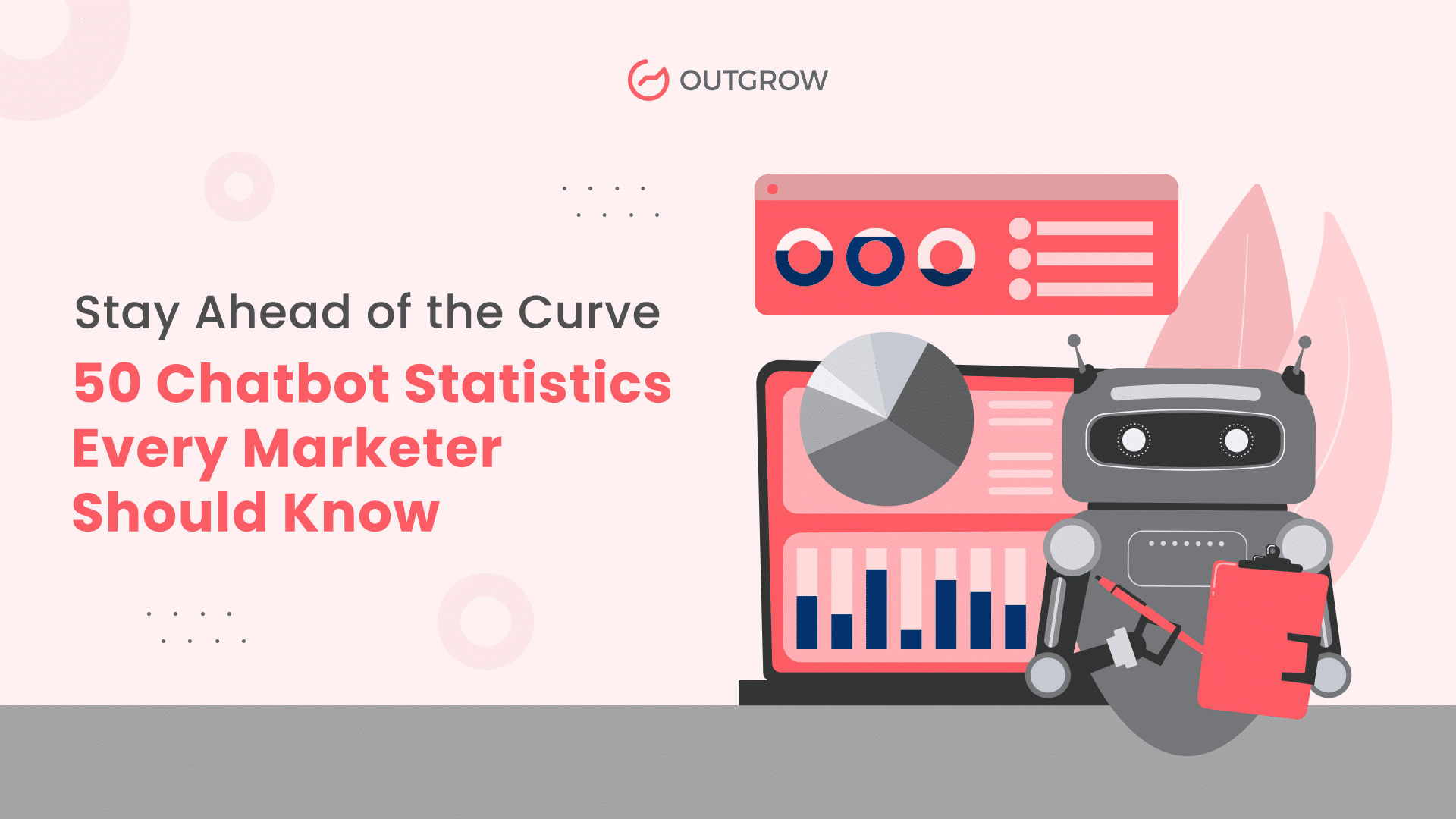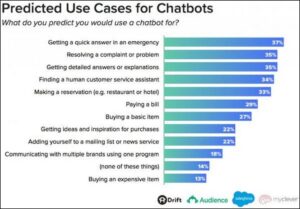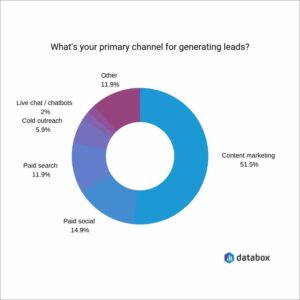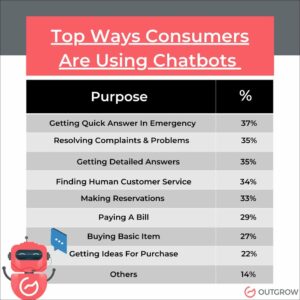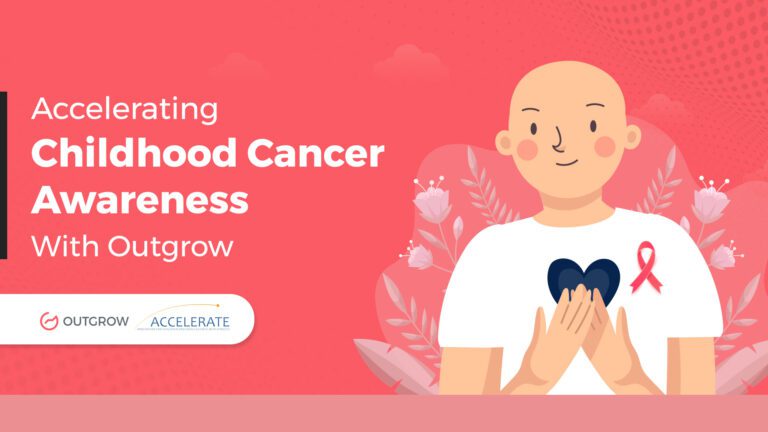Stay Ahead of the Curve: 50 Chatbot Statistics Every Marketer Should Know
Table of Contents
Welcome, ladies, and gentlemen. The future is here. It’s the age of technology, easy communication, and well-informed consumers. And this growing need for quick, easy, and effective results has resulted in – you guessed it – the rise of chatbots. And we are here with some vital chatbot statistics that will help you develop key strategies for your business!

Are you up to speed with this latest development? To ensure that you stay aboard this (extremely fast-moving) chatbot rollercoaster, we present 50+ Chatbot Statistics that will give you all the insight you need to become a chatbot expert.
Let’s begin, shall we? Hold on tight!
Uses of Chatbots
Consumers today expect to find the information they’re looking for online quickly and easily. And when a business can’t provide them with an efficient experience, it leads to unrest. Chatbots are poised to ease these frustrations by providing the real-time, on-demand responses that consumers are increasingly seeking out.
How Chatbots Have Fared With the Customers
1. 88% of users had at least one conversation with a chatbot in 2022.
2. Using chatbots only resulted in 80% consumer satisfaction since most chatbots are programmed to deliver accurate results.
3. 69% of consumers were satisfied with their last interaction with a chatbot. It’s an excellent result for an automated assistant. Meanwhile, 21% of respondents remained neutral, and only 10% were unsatisfied with a chatbot conversation.
4. 80% of consumers in a recent survey said they are more willing to use a chatbot if they know they can quickly and easily transfer to a live agent.
5. Only 1 in 10 customers rated their last interaction with a chatbot as negative.
6. There are multiple types of chatbots.
Here is the percentage of page visitors who interacted with a specific kind of chatbot:
- 20% upselling chatbots
- 14% discount chatbots
- 11% chatbots for ordering phone calls
- 6% CSAT survey bots
- 19% AI chatbots
- 11% abandoned cart chatbots
- 10% lead generation chatbots
- 4% of chatbots created from scratch by users
- 4% product recommendation chatbots
- 1% exit intent chatbots
7. 74% of customers would choose a chatbot over a human agent to look for answers to simple questions.
8. About 53% of respondents find waiting too long for replies the most frustrating part of interacting with businesses.
9. Popularity of chatbots – 96% of customers heard about chatbots and know what they are.
10. If the alternative were to wait 15 minutes for an answer, 62% of consumers would rather talk to a chatbot than a human agent.
Chatbot: The Go-To Customer Support
Good customer service is a must if you want your customers to keep coming back to you. More than acquiring customers, it’s important to retain them. In fact, acquiring new customers costs more than retaining existing ones.
And that’s what chatbots are here for! See how chatbots rule the customer support world with these amazing chatbot customer service statistics:
1. About 90% of customer queries are resolved in 10 messages or fewer.
2. Only 17% of customers believe that companies overuse chatbots, making it too difficult to reach human agents.
3. 64% of businesses trust chatbots to provide personalized customer support rather than regular customer service.
4. 60% of consumers would still prefer to wait in queue for a real agent to reply rather than receive an instant response from a chatbot.
5. 34% of customers prefer communicating with a customer agent via chatbot protocol instead of phone or live interaction.
Chatbot: The Conversion Machine
Yes yes, we love us some leads. And, chatbots are one of the most effective ways of lead generation. They offer valuable solutions and engage the customer in exchange for valuable lead information. In fact, according to Databox research, these marketing channels yield the most leads:
Check out more chatbot engagement statistics about how they help you convert a lot better!
1. Giants such as LinkedIn, Starbucks, British Airways, and eBay continue using chatbots in 2022.
2. The conversion rate of chatbots in some industries can reach up to 70%.
3. 7-25% is the revenue chatbots bring to the online store.
4. 57% of businesses state that chatbot usage results in a significant ROI with minimal investments
5. Business leaders claim that on average, chatbots have increased sales by 67%.
6. 84% of companies believe that AI chatbots will gain importance for customer communication.
7. A popular internet game reported 2+ billion players used chatbots to raise queries during the gameplay and received direct replies without delay.
8. 39% of all chats between businesses and consumers involve a chatbot.
9. 58% of the companies that turn to the chatbot market are B2B, and 65.1% are SaaS businesses.
10. The average length of a chatbot conversation is 5.7 messages.
11. About 3 in 4 companies were satisfied with the results that introduced chatbots.
12. 55% of companies that use chatbots get more high-quality leads.
13. Chatbots are used for upselling in about 20% of cases.
14. 36% of companies turn to the chatbot market to improve lead generation.
15. 34% of online retail customers accept using chatbots.
16. Only 9% of online stores worldwide set up chatbots on their websites.
17. 38.9% of companies that use chatbots are in the IT software and service sector.
Chatbot: The Dynamic
By now, you should know that chatbots are everywhere. Moreover, they are used for almost everything. Anything that requires automation has a chatbot in it.
Here are some chatbot growth statistics for you to understand the dynamism of chatbots
1. The top 5 industries profiting from the incorporation of chatbots are:
a. Real estate- 28%
b. Travel 16%
c. Education 14%
d. Healthcare 10%
f. Finance 5%
2. The top 5 chatbot-using countries are the United States, India, Germany, the United Kingdom, and Brazil. Roughly 1.5 billion people are using chatbots, most of which are located in those 5 countries.
3. In 2023, the chatbot market is projected to grow by over $994 million. This huge growth indicates an annual gain of around $200 million. With its current compound annual growth rate (CAGR) of about 22%, we can expect this number to reach 3 billion dollars by the end of this decade.
4. Another trend for 2023 is the rise of AI-powered GTP-3 chatbots. GTP-3 is a language model developed by OpenAI, presenting a state-of-the-art natural language processing model. It became available to the general public in late 2022, and the internet went crazy. It is predicted that businesses will soon have a chatbot and use the GPT-3 technologies to assist customers more effectively.
5. In 2022, the total cost savings from deploying chatbots reached around $11 billion. And this number will only continue to grow as more and more businesses adopt the technology. It’s not really surprising, as chatbots can save businesses up to 30% of costs on customer support alone.
Chatbots in Healthcare
1. By 2026, the healthcare chatbots market will reach $543 million.
2. Around 52% of patients in the US acquire their health data through the use of healthcare chatbots.
3. Globally, healthcare chatbots help save as much as $3.6 billion.
Chatbots in Finance
1. The size of the chatbot market in BFSI (banking, financial services, and insurance) is estimated to reach nearly $7 billion by 2030
2. The use of financial services chatbots can help customers save around 4 minutes per inquiry which will directly add value to customer satisfaction
3. As many as 43% of banking customers prefer to resolve any issues through a chatbot
Customers are using chatbots in multiple ways to make their processes smoother. Here are some of them:
The Future of Chatbots
Check out these stats regarding what the future holds for chatbots:
1. By 2027, chatbots can become the primary customer support channel for a quarter of all companies.
2. $112B is the sum chatbot transactions are expected to reach in 2023.
3. One-third of AI startup founders believe that chatbots will be the most popular customer tech in the next five years.
4. In 2023, chatbots are expected to save businesses up to 2.5 billion hours of work.
5. More and more businesses are introducing this technology into their marketing routine and customer support processes. By 2024, the global chatbot market is expected to reach $994 million.
Introduction of AI in Chatbots
AI has had a significant impact on the chatbot industry. AI-powered chatbots are now more sophisticated and capable of handling complex tasks and interactions. Natural Language Processing (NLP) and Machine Learning (ML) techniques have improved chatbots’ ability to understand and respond to customer inquiries and requests.
AI-powered chatbots have also become more personalized and context-aware, allowing them to provide tailored responses to individual customers based on their previous interactions and preferences. This has led to an increase in customer satisfaction and loyalty.
Moreover, AI has enabled chatbots to be integrated with other AI-powered tools and systems, such as voice assistants and smart home devices, to create a seamless and unified customer experience across multiple channels and devices.
Overall, AI has played a vital role in advancing the capabilities of chatbots, making them more effective and efficient in delivering real-time customer service and support.
Conclusion
It’s essential to remember that chatbots have their limitations, just like any other technology. Therefore, the key takeaway is that there’s no need to choose between chatbots or humans as businesses can utilize chatbots to complement their human workforce rather than replace them. By incorporating chatbots with online chat and the invaluable human touch, companies can instantaneous service bound to satisfy their clients.
Are you ready for it? Start building your own chatbot with Outgrow now! You can get started for free with this 7-day free trial.
Read Next : Best Practices for Building a Chatbot
Sources:
- Tidio – https://www.tidio.com/blog/chatbot-statistics/
- Servicebell – https://www.servicebell.com/post/chatbot-statistics
- Chain storeage – https://chainstoreage.com/survey-customer-expectations-chatbots-are
- Chatbot.com – https://www.chatbot.com/blog/chatbot-statistics/
- Blogging wizard – https://bloggingwizard.com/chatbot-statistics/
- Research.ai multiple – https://research.aimultiple.com/chatbot-stats/
- Backlinko – https://backlinko.com/chatbot-stats
- Invespcro – https://www.invespcro.com/blog/chatbots-customer-service/
- Revechat – https://www.revechat.com/blog/chatbots-trends-stats/
- Spiceworks – https://www.spiceworks.com/marketing/ai-in-marketing/articles/b2b-marketers-say-chatbots-increase-lead-conversion-rates/

